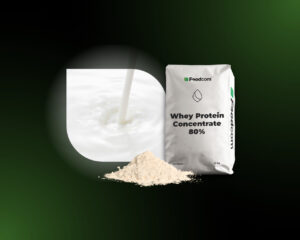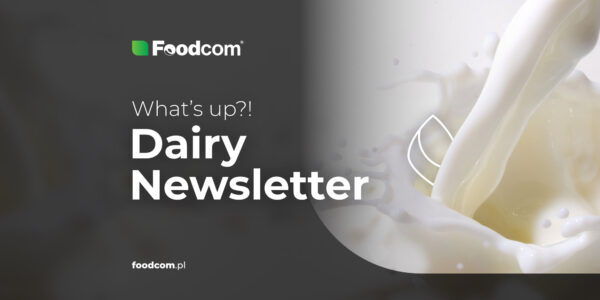Hello, Partners!
As the sun sets over summer, it’s time to embrace the familiar desk in the beloved office. But in the midst of this transition, there is a buzz in the air as people from all over the world slowly begin to set course for Anuga in Cologne (where you can meet us too). The market is awakening with renewed energy, and attendees are preparing for some promising business.
What else was going on in the market? Read on!
Best of Luck!
PRODUCTS
SMP
It’s not the easiest product to trade today, but due to very high temperatures in the Netherlands and France and weaker milk intake, a few of the producers raised the prices a little bit last week. In the end, not too much business in Skimmed Milk Powder was done. We heard that the feed sector might be waking up after months of lethargy. If that happens – this might drive the prices up.
Butter
Last week, the price of liquid Cream has increased, making it almost impossible to trade freshly made Butter. Polish manufacturers are on very high levels starting even 4,80 EUR/KG at the beginning, especially compared to Irish origin, which is still the most competitive material on the market.
FCMP
A notable shift is the focus on EU production of FCMP based on customer orders. This customized approach allows for greater flexibility and responsiveness to specific market demands. As a result, inventories are managed efficiently to ensure they can meet demand, albeit with an interesting twist. Interest in FCMP remains stable, and the market is showing signs of cautious optimism.
Cream
The cream market remains resilient and in demand, with prices holding steady. Clearly, maintaining a stable supply of this dairy product is critical. Fortunately, industry reports indicate that most processing requirements are being adequately met, ensuring a steady flow of cream for various applications.
WPC
Every active Trader is asking the same questions. Is this the same price rally we saw in Whey Protein Concentrates 2 years ago? But no one has a crystal ball with an answer to that question. Regular is on the market as opposed to instant. It’s very hard to predict where the market will go, but, definitely, those who have stocked up are pretty happy these days.
Cheeses
In the past week, cheese prices have inched up, and there’s a noticeable surge in consumer interest, especially in Mozzarella, Cagliata, and Gouda cheeses. Keep an eye out for how these trends unfold in the upcoming week; it’s shaping up to be an exciting cheese journey!
WHAT ELSE?
EUROPE
UK
Dairy farmers in the UK are facing increasing losses as milk prices remain 5-10 pence per litre below the current cost of production estimates. Despite low prices, milk supply remains high, with deliveries slightly up from the previous year. There is still a risk of further price reductions, although there was a 2.7% increase in prices at the Global Dairy Trade auction in September.
Ukraine
From January to July 2023, Ukraine exported 15.7 thousand tons of non-condensed milk and cream, with a 2.6% increase in volume, amounting to $9 million in export revenue. The primary buyers were Moldova (91.2%), Georgia (3.4%), and Armenia (3%). Additionally, condensed milk and cream exports for the same period rose by 32.8% to 17.4 thousand tons, but the monetary value decreased by 6.2% to $43.9 million compared to January-July 2022.
THE AMERICAS
Argentina
Dairy consumption in Argentina is declining due to reduced purchasing power, worsened by currency devaluation after the PASO primary elections. Surveys indicate a 19% decrease in consumption, aligning with overall trends. Globally, dairy product prices are falling, posing risks to the Argentine dairy industry, with bankruptcy looming for various stakeholders.
Chile
The global dairy industry faces uncertainty as international dairy prices decline due to reduced demand from China, the world’s largest buyer of dairy products. Prices, including whole milk powder, have dropped significantly in recent days. While there is hope for a medium-term recovery, the Argentine dairy sector is currently grappling with short-term challenges and the need for economic incentives to support local producers and counter the impact of global market fluctuations.
ASIA & OCEANIA
China
Since the start of the COVID-19 pandemic, liquid milk sales have grown by 19% in China, particularly driven by the perception of milk as an immune system booster. However, foreign milk brands have struggled to adapt to changing consumer preferences, with their market share dropping from 12.8% in Q2 2022 to 8.3% in Q2 2023. Successful brands have catered to the premium market by emphasizing unique milk sources, farming environments, and specific nutrients to meet consumer needs.
New Zealand
The New Zealand dairy sector has become a vital component of the country’s economy, contributing nearly NZ$26 billion in export revenue over the past year, with dairy products accounting for one in every four export dollars. Despite fluctuations in milk prices, the industry serves as a crucial source of employment, supporting 55,000 jobs and injecting NZ$3.6 billion into wages annually, benefiting local communities. Additionally, there has been a notable shift toward exporting more dairy protein products and reduced volumes of whole milk powder in response to changing market demands.







